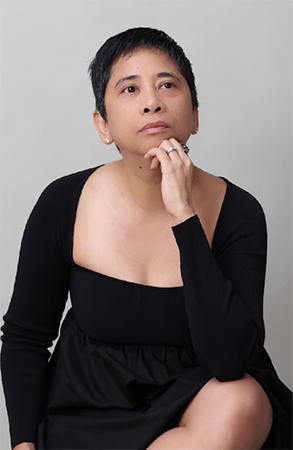The Monsters in Our Midst
/The Secret Lives of OFWs
by Jet Tagasa (Penguin Random House SEA, January 2025)
The Secret Lives of OFWs is a compilation of fictional short stories about Overseas Filipino Workers. The domestic helper, nurse, waiter, seafarer, and cook among them, all moved abroad in search for a better life, all experienced abuse, and all transform into a mythical creature–the likes of aswang (witch), oryol (snake-woman) or manananggal (viscera sucker)–to exact revenge.
It’s written by Manila-based Jet Tagasa. She was an OFW for many years, working as a broadcast media professional in both Hong Kong and Dubai.
“It all started with the first story, the Domestic Helper, which I wrote in 2017 to process my distress at hearing about, what felt like at the time, one too many news reports of Filipina domestic helpers dying at the hands of their employers in the Middle East. It was a way of working out the helplessness I felt over the injustice and suffering that many Filipinos working abroad, unfortunately, encounter.”
Jet Tagasa is the author of The Secret Lives of OFWs. “Writing in this genre is an exploration of my fascination with the macabre. A way for me to discover and figure out why I like it so much.” (Photo courtesy of Jet Tagasa)
She kept writing more stories to show that while there is suffering, there is also strength, and power. In a way, she says, transforming his OFW characters into mythological beings reflects the near-mythic resilience of Filipinos—of our uncanny power to endure, adapt, and flourish.
“I suppose this is where the supernatural element comes in handy. Merging my stories with Philippine folklore is a way of adding power to stories of helplessness. A way of saying that all of us have an inner monster we can tap into, to overcome monster challenges. Making these stories more than just about suffering, but also, of hope.”
Tagasa has always been drawn to the horror genre as a reader and as a writer, finding that the most interesting and compelling stories come out of scary experiences or situations. She likes stories of what makes something evil or scary and of people who have faced evil and somehow survived.
House of Monstrous Women
By Daphne Fama (Penguin Random House, August 2025)
House of Monstrous Women is a gothic horror novel that takes place in 1986 Philippines. It’s set in an old mansion on a remote island accessible only by small boat and a trek in the forest. There are many rooms but no electricity, and the townsfolk believe this is home to an aswang (witch). And yet this is the chosen reunion venue of four childhood friends.
Josephine, Alejandro, Gabriela, and Hiraya are victims of the Marcos dictatorship and long for the simplicity of their past life. They are here to play tagu-tagu, a game of hide and seek, where the winner is guaranteed the future they long for, and the loser dies. Can they survive the game, and will their friendship survive?
Written by Daphne Fama, who was born and based in the US but still deeply connected to her Filipino heritage. She credits this to her mother: “She brought me to the Philippines for the first time when I was nine, then every year after that until I was 23. My mother, a classic extrovert, also dove headfirst into the Filipino community an hour away from our house. Every weekend we’d be at these Filipino parties, four-hour long dinners full of gossip and laughter, populated by Filipino women, their lost-looking husbands, and children just like me. Back then, I thought those parties were a drag, but now I appreciate those moments so much.”
Daphne Fama is the author of House of Monstrous Women. “It was absolutely a labor of love. When I see it on my shelf now, I can only appreciate it. It has ugliness, but it’s ultimately a novel about independence, freedom, and hope. I feel lighter now that it’s out in the world.” (Photo by Rose Fama)
House of Monstrous Women was born from childhood stories, the suffering of Fama’s mother and grandmother, and her own frustration with the current political system.
“When I was young, my mother shared plenty of stories about the monsters of her childhood. The sigbin (blood-sucking goat), kapre (ape-like tricksters), and duwende (mischievous elf) were common characters. But one story truly took root in me. A family my mother knew was accused of being aswang (witch). She was friends with the daughter, but the ostracization and judgement were too much for the family, and they left town, changing their names. I empathized with the girl accused of being an aswang, which became a core part of the book.”
House of Monstrous Women is more than monsters and folklore. It’s also a novel that takes place during the People Power Revolution, a peaceful movement in which hundreds of thousands of people gathered to protest the tyranny of then-dictator Ferdinand Marcos.
“When the Marcos family reappeared in the political arena trying to rewrite the past, I was so frustrated by how they were trying to rewrite history,” Fama relates. “I wanted to bring mainstream attention to both the revolution, that period of history, and how people can truly make a difference if they come together.”
She’s a lifelong reader of horror. “It probably goes without saying that I was also a shameless coward. I was afraid of the dark, of mirrors at night. And yet the unknown thrilled me, drawing me in. As I’ve grown older, I now know I love horror because it gives a face to the faceless, something that can be fought against and overcome. If there is a monster in the dark, it can be slain. A mirror can be shattered.”
The images evoke feelings of terror and repulsion, tapping into our greatest fears.
As a writer horror for Fama is therapy. Her fears are rooted in loss of agency, the consequences of living outside of societal norms, and the thorny complexity of love. “But in House of Monstrous Women the main character, Josephine, faces each of these “monsters” and overcomes them,” Daphne concludes.
The stories in The Secret Life of OFWs and House of Monstrous Women echo the horrors happening in the world today. From the dreadful experiences of immigrants, who are in a way ghosts because they are often unseen and unnoticed, to widespread corruption by monsters in government. It’s also an opportunity to introduce Filipino mythological creatures and regional legends to new audiences, thereby preserving them. Horror can be about fear. But it can also be how we take action.
Claire Mercado-Obias is a writer, food stylist and pastry chef based in New Jersey.
More articles from Claire Mercado-Obias







